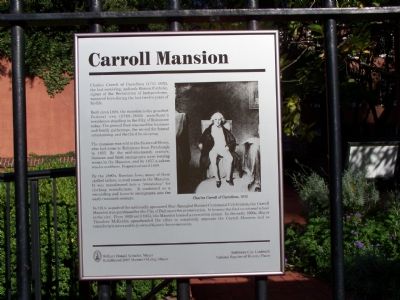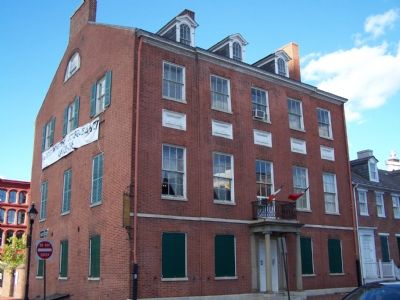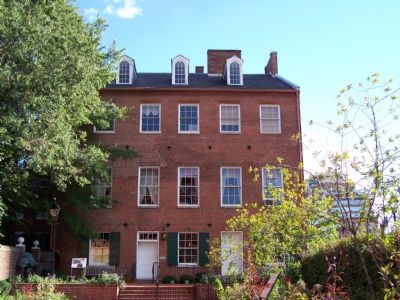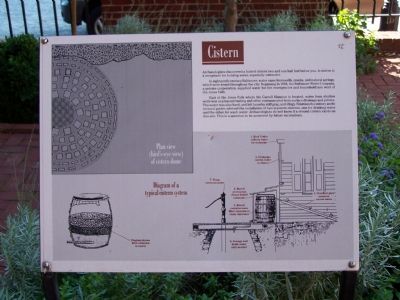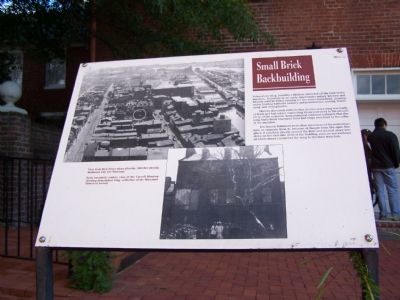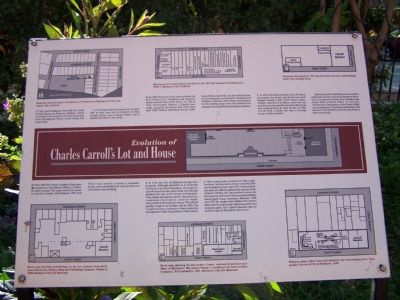Jonestown in Baltimore, Maryland — The American Northeast (Mid-Atlantic)
Carroll Mansion
Built circa 1808, the mansion is the grandest Federal era (1780–1820) merchant’s townhouse standing in the City of Baltimore today. The ground floor was used for business and family gatherings, the second for formal entertaining, and the third for sleeping.
The mansion was sold to the Sisters of Mercy, who had come to Baltimore from Pittsburgh in 1855. By the mid-nineteenth century, German and Irish immigrants were renting rooms in the Mansion, and by 1857 a saloon was located here. It operated until 1889.
By the 1890’s, Russian Jews, many of them skilled tailors, rented rooms in the Mansion. It was transformed into a “sweatshop” for clothing manufacture. It continued as a sweatshop and home to immigrants into the early twentieth century.
In 1914, as part of the nationally sponsored Star-Spangled Banner Centennial Celebration, the Carroll Mansion was purchased by the City of Baltimore for preservation. It became the first vocational school in the city. From 1929 until 1954, the Mansion housed a recreation center. In the early 1960’s Mayor Theodore McKeldin spearheaded the effort to completely renovate the Carroll Mansion and to transform it into a publicly owned historic house museum.
Erected by the City of Baltimore, William Donald Schaefer, mayor, rededicated 2005 by Martin O'Malley, mayor.
Topics and series. This historical marker is listed in these topic lists: Architecture • Churches & Religion • Industry & Commerce • Patriots & Patriotism • Settlements & Settlers • War, US Revolutionary • Women. In addition, it is included in the Maryland, Baltimore City historical markers, and the Signers of the Declaration of Independence series lists. A significant historical year for this entry is 1808.
Location. 39° 17.319′ N, 76° 36.275′ W. Marker is in Baltimore, Maryland. It is in Jonestown. Marker is on Front Street, 0.1 miles north of Lombard Street, on the left when traveling south. Touch for map. Marker is in this post office area: Baltimore MD 21202, United States of America. Touch for directions.
Other nearby markers. At least 8 other markers are within walking distance of this marker. Cistern (here, next to this marker); Small Brick Building (a few steps from this marker); Home of Edward Johnson (within shouting distance of this marker); Cast-Iron Façade (within shouting distance of this marker); Brewer’s Park (within shouting distance of this marker); The Star Spangled Banner Flag was Born Here (within shouting distance of this marker); Flag House (about 500 feet away, measured in a direct line); Welcome To The Star-Spangled Banner Flag House (about 500 feet away). Touch for a list and map of all markers in Baltimore.
Also see . . . Charles Carroll of Carrollton. (Submitted on October 28, 2007, by Bill Pfingsten of Bel Air, Maryland.)
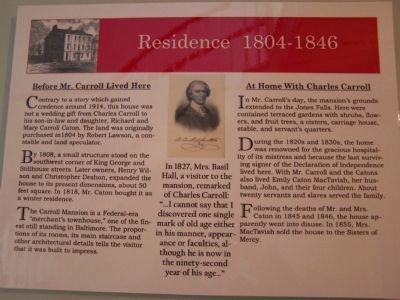
Photographed By William Pfingsten, March 8, 2008
4. Residence 1804 - 1846 Interior marker in Carroll Mansion
Before Mr. Carroll Lived Here
Contrary to a story which gained credence around 1914, this house was not a wedding gift from Charles Carroll to his son-in-law and daughter, Richard and Mary Carroll Caton. The land was originally purchased in 1804 by Robert Lawson, a constable and land speculator.
By 1808, a small structure stood on the southwest corner of King George and Stillhouse streets. Later owners, Henry Wilson and Christopher Deshon, expanded the house to its present dimensions, about 50 feet square. In 1818, Mr. Caton bought it as a winter residence.
The Carroll Mansion is a federal-era "merchant's townhouse," one of the finest still standing in Baltimore. The proportions of its rooms, its main staircase and other architectural details tells the visitor that it was built to impress.
At Home With Charles Carroll
In Mr. Carroll's day, the mansion's grounds extended to the Jones Falls. Here were contained terraced gardens with shrubs, flowers, and fruit trees, a cistern, carriage house, stable, and servant's quarters.
During the 1820s and 1830s, the home was renowned for the gracious hospitality of its mistress and because the last surviving signer of the Declaration of Independence lived here. With Mr. Carroll and the Catons also lived Emily Caton MacTavish, her husband, John, and their four children. About twenty servants and slaves served the family.
Following the deaths of Mr. and Mrs. Caton in 1845 and 1846, the house apparently went into disuse. In 1855 Mrs. MacTavish sold the house to the Sisters of Mercy.
Insert
In 1827, Mrs. Basil Hall, a visitor to the mansion, remarked of Charles Carroll: "...I cannot say that I discovered one single mark of old age either in his manner, appearance or faculties, although he is now in the ninety-second year of his age..."
Contrary to a story which gained credence around 1914, this house was not a wedding gift from Charles Carroll to his son-in-law and daughter, Richard and Mary Carroll Caton. The land was originally purchased in 1804 by Robert Lawson, a constable and land speculator.
By 1808, a small structure stood on the southwest corner of King George and Stillhouse streets. Later owners, Henry Wilson and Christopher Deshon, expanded the house to its present dimensions, about 50 feet square. In 1818, Mr. Caton bought it as a winter residence.
The Carroll Mansion is a federal-era "merchant's townhouse," one of the finest still standing in Baltimore. The proportions of its rooms, its main staircase and other architectural details tells the visitor that it was built to impress.
At Home With Charles Carroll
In Mr. Carroll's day, the mansion's grounds extended to the Jones Falls. Here were contained terraced gardens with shrubs, flowers, and fruit trees, a cistern, carriage house, stable, and servant's quarters.
During the 1820s and 1830s, the home was renowned for the gracious hospitality of its mistress and because the last surviving signer of the Declaration of Independence lived here. With Mr. Carroll and the Catons also lived Emily Caton MacTavish, her husband, John, and their four children. About twenty servants and slaves served the family.
Following the deaths of Mr. and Mrs. Caton in 1845 and 1846, the house apparently went into disuse. In 1855 Mrs. MacTavish sold the house to the Sisters of Mercy.
Insert
In 1827, Mrs. Basil Hall, a visitor to the mansion, remarked of Charles Carroll: "...I cannot say that I discovered one single mark of old age either in his manner, appearance or faculties, although he is now in the ninety-second year of his age..."
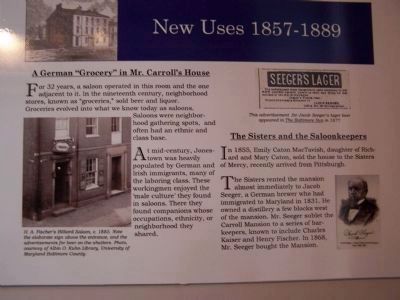
Photographed By William Pfingsten, March 8, 2008
5. Marker describing later uses of the Carroll Mansion - New Uses 1857 - 1889
A German "Grocery" in Mr. Carroll's House
For 32 years, a saloon operated in this room and the one adjacent to it. In the nineteenth century, neighborhood stores known as "groceries," sold beer and liquor. Groceries evolved into what we know today as saloons. Saloons were neighborhood gathering spots, and often had an ethnic and class base.
At mid-century, Jonestown was heavily populated by German and Irish immigrants, many of the laboring class. These workingmen enjoyed the 'male culture' they found in saloons. There they found companions whose occupations, ethnicity, or neighborhood they shared.
The Sisters and the Saloonkeepers
In 1855, Emily Caton MacTavish, daughter of Richard and Mary Caton, sold the house to the Sisters of Mercy, recently arrived from Pittsburgh.
The Sisters rented the mansion almost immediately to Jacob Seeger, a German brewer who had immigrated to Maryland in 1831. he owned a distillery a few blocks west of the mansion. Mr. Seeger sublet the Carroll Mansion to a series of barkeepers, known to include Charles Kaiser and Henry Fischer. In 1868, Mr. Seeger bought the Mansion
Left Photo
H. A. Fischer's Billiard Saloon, c. 1885. Note the elaborate sign above the entrance, and the advertisements for beer on the shutters. Photo courtesy of Albin O. Kuhn Library, University of Maryland Baltimore County.
Right Insert
Seeger's Lager
This advertisement for Jacob Seeger's lager beer appeared in The Baltimore Sun in 1877.
For 32 years, a saloon operated in this room and the one adjacent to it. In the nineteenth century, neighborhood stores known as "groceries," sold beer and liquor. Groceries evolved into what we know today as saloons. Saloons were neighborhood gathering spots, and often had an ethnic and class base.
At mid-century, Jonestown was heavily populated by German and Irish immigrants, many of the laboring class. These workingmen enjoyed the 'male culture' they found in saloons. There they found companions whose occupations, ethnicity, or neighborhood they shared.
The Sisters and the Saloonkeepers
In 1855, Emily Caton MacTavish, daughter of Richard and Mary Caton, sold the house to the Sisters of Mercy, recently arrived from Pittsburgh.
The Sisters rented the mansion almost immediately to Jacob Seeger, a German brewer who had immigrated to Maryland in 1831. he owned a distillery a few blocks west of the mansion. Mr. Seeger sublet the Carroll Mansion to a series of barkeepers, known to include Charles Kaiser and Henry Fischer. In 1868, Mr. Seeger bought the Mansion
Left Photo
H. A. Fischer's Billiard Saloon, c. 1885. Note the elaborate sign above the entrance, and the advertisements for beer on the shutters. Photo courtesy of Albin O. Kuhn Library, University of Maryland Baltimore County.
Right Insert
Seeger's Lager
This advertisement for Jacob Seeger's lager beer appeared in The Baltimore Sun in 1877.
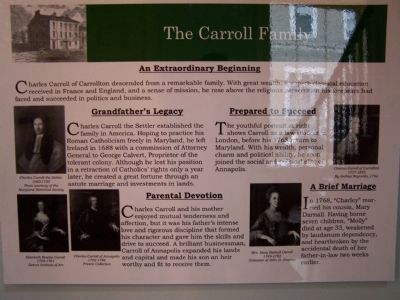
Photographed By William Pfingsten, March 8, 2008
6. The Carroll Family - Interior Marker
An Extraordinary Beginning
Charles Carroll of Carrollton descended from a remarkable family. With great wealth, a superb classical education received in France and England, and a sense of mission, he rose above the religious persecution his forebears had faced and succeeded in politics and business.
Grandfather's Legacy
Charles Carroll the Settler established the family in America. Hoping to practice his Roman Catholicism freely in Maryland, he left Ireland in 1688 with a commission of Attorney General to George Calvert, Proprietor of the tolerant colony. Although he lost his position in a retraction of Catholics' rights only a year later, he created a great fortune through an astute marriage and investments in lands.
Parental Devotion
Charles Carroll and his mother enjoyed mutual tenderness and affection, but it was his father's intense love and rigorous discipline that formed his character and gave him the skills and drive to succeed. A brilliant businessman, Carroll of Annapolis expanded his lands and capital and made his son an heir worthy and fit to receive them.
Prepared to Succeed
The youthful portrait at right shows Carroll as a law student in London, before his 1765 return to Maryland. With his wealth, personal charm and political ability he soon joined the social and political elite of Annapolis.
A Brief Marriage
In 1768, "Charley" married his cousin, Mary Darnall. Having borne seven children, "Molly" died at age 33, weakened by laudanum dependency, and heartbroken by the accidental death of her father-in-law two weeks earlier.
Photo Top Left Charles Carroll the Settler 1660-1720 Photo Bottom Left Elizabeth Brooks Carroll 1709-1761 Photo Bottom Middle Charles Carroll of Annapolis 1702-1782 Photo Top Right Charles Carroll of Carrollton 1737-1832 Photo Bottom Right Mrs. Mary Darnall Carroll 1749-1782
Charles Carroll of Carrollton descended from a remarkable family. With great wealth, a superb classical education received in France and England, and a sense of mission, he rose above the religious persecution his forebears had faced and succeeded in politics and business.
Grandfather's Legacy
Charles Carroll the Settler established the family in America. Hoping to practice his Roman Catholicism freely in Maryland, he left Ireland in 1688 with a commission of Attorney General to George Calvert, Proprietor of the tolerant colony. Although he lost his position in a retraction of Catholics' rights only a year later, he created a great fortune through an astute marriage and investments in lands.
Parental Devotion
Charles Carroll and his mother enjoyed mutual tenderness and affection, but it was his father's intense love and rigorous discipline that formed his character and gave him the skills and drive to succeed. A brilliant businessman, Carroll of Annapolis expanded his lands and capital and made his son an heir worthy and fit to receive them.
Prepared to Succeed
The youthful portrait at right shows Carroll as a law student in London, before his 1765 return to Maryland. With his wealth, personal charm and political ability he soon joined the social and political elite of Annapolis.
A Brief Marriage
In 1768, "Charley" married his cousin, Mary Darnall. Having borne seven children, "Molly" died at age 33, weakened by laudanum dependency, and heartbroken by the accidental death of her father-in-law two weeks earlier.
Photo Top Left Charles Carroll the Settler 1660-1720 Photo Bottom Left Elizabeth Brooks Carroll 1709-1761 Photo Bottom Middle Charles Carroll of Annapolis 1702-1782 Photo Top Right Charles Carroll of Carrollton 1737-1832 Photo Bottom Right Mrs. Mary Darnall Carroll 1749-1782
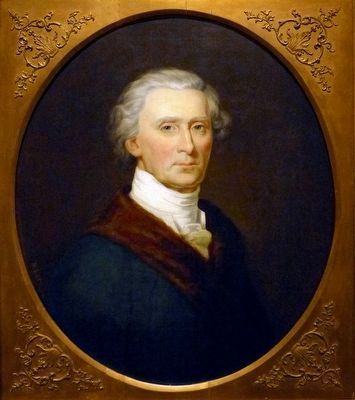
Photographed By Allen C. Browne, September 5, 2015
7. Charles Carroll of Carrollton
This c. 1847 portrait of Charles Carroll of Carrollton by Michael Laty (after Robert Field) hangs in the Maryland Historical Society Museum in Baltimore, Maryland.
“Charles Carroll of Carrollton was born in Annapolis to Charles Carroll of Annapolis (1702-1782) and his wife, Elizabeth Brooke (1709-1761). After studying civil law at the College of St. Louis Le Grand, Rheims, France, and common law at The Temple, London, he returned to Maryland in 1765. One of the earliest advocates for independence, the wealthy and influential Carroll served as a delegate to the Continental Congress and the Confederation Congress. He was the only Catholic to sign the Declaration of Independence and the last surviving signer, dying at 95 years of age...” — Maryland Historical Society
“Charles Carroll of Carrollton was born in Annapolis to Charles Carroll of Annapolis (1702-1782) and his wife, Elizabeth Brooke (1709-1761). After studying civil law at the College of St. Louis Le Grand, Rheims, France, and common law at The Temple, London, he returned to Maryland in 1765. One of the earliest advocates for independence, the wealthy and influential Carroll served as a delegate to the Continental Congress and the Confederation Congress. He was the only Catholic to sign the Declaration of Independence and the last surviving signer, dying at 95 years of age...” — Maryland Historical Society
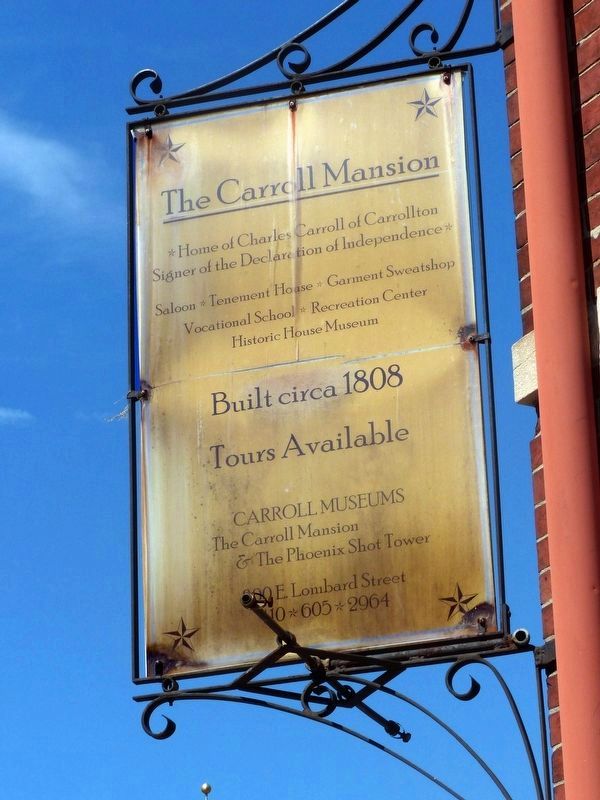
Photographed By Allen C. Browne, August 28, 2016
8. The Carroll Mansion
signer of the Declaration of Independence ★
Saloon ★ Tenement House ★ Garment Sweatshop
Vocational School ★ Recreation Center
Historic Home Museum
Built circa 1808
Tours Available
Carroll Museums
The Carroll Mansion
& Phoenix Shot Tower
800 E. Lombard Street
410-605 9964
Credits. This page was last revised on April 17, 2020. It was originally submitted on October 28, 2007, by Bill Pfingsten of Bel Air, Maryland. This page has been viewed 5,065 times since then and 56 times this year. Photos: 1, 2, 3. submitted on October 28, 2007, by Bill Pfingsten of Bel Air, Maryland. 4, 5, 6. submitted on March 10, 2008, by Bill Pfingsten of Bel Air, Maryland. 7. submitted on September 7, 2015, by Allen C. Browne of Silver Spring, Maryland. 8. submitted on December 17, 2016, by Allen C. Browne of Silver Spring, Maryland. 9, 10, 11. submitted on October 28, 2007, by Bill Pfingsten of Bel Air, Maryland. • J. J. Prats was the editor who published this page.
